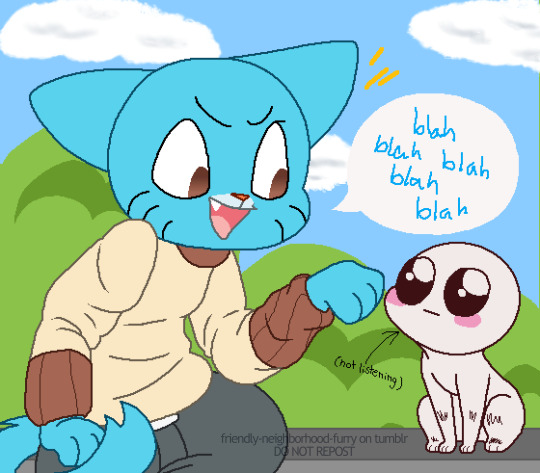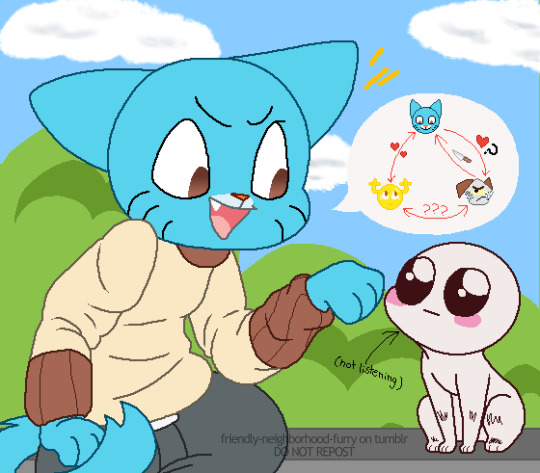#every so often i go “aw i love doing pixel art its so satisfying why did i stop doing it?”
Text

decided to do a little "return to form" with some silly pixel art!! :3
i don't remember what possessed me to draw these two specifically hanging out but whatever, it was fun! i had fun!!!
alt version where he's rambling about the weird fucked up polycule situation he put himself in lol

#i'll talk about the “polycule” thing some other time cuz i have a lot of thoughts about the three of them#but for now that little triangle chart is good enough#every so often i go “aw i love doing pixel art its so satisfying why did i stop doing it?”#and then it smash cuts to eighteen and a half hours later and you see me staring at my computer screen with sunken bloodshot eyes#and the most insane case of shrimp posture ever exhibited by a human being#erasing and then replacing the same two goddamn pixels trying to figure out what the hell i'm doing wrong here for it to look so off#and then i zoom out to discover i've been tracing over the worst piece of shit sketch ever crafted by human hands#and so i set my PC on fire in shame and crawl back into my burrow#vowing never to do pixel art ever again#and then like 8 month pass and i go “aw i love doing pixel art its so satisfying why did i stop doing it?” and the cycle repeats itself#/hj#the amazing world of gumball#tawog#gumball watterson#tbh creature#autism creature#my art#gumball tawog#tawog gumball#gumball#tawog fanart#tawog fan art#fan art#pixel art#colored lineart#colored line art#yippee
41 notes
·
View notes
Photo

Suuuper gaaaayyyyyy.
Anyways, I wanted to say more on why Erina is a festering sack-of-shit garbage person. Firstly, her opinions on food are just objectively wrong. She turns up her nose at ‘common, peasant food’ which is weird on multiple levels: not only can any cook with a modicum of food history be able to explain the extent to which haute cuisine draws upon and is nourished by common peasant traditions (I mean fancy French cuisine itself is nothing but this particular interplay) but there has been a significant trend over the last decade in high cuisine towards rusticism - the locavore movement being perhaps its most visible influence that has bled into the mainstream: the tendency over the last decade-and-change towards deconstructionism of high food culture - both in molecular gastronomy and its diametric opposite in rusticism - is something she seems utterly ignorant of, as though her only experience with food is overpriced French restaurants that cater to the gullible by overloading every plate with a plethora of nonsense. It often seems that she has contempt for simplicity - which seems ridiculous given that her birth culture gave us the elegance of sashimi, a venerable culinary tradition whose masters attempt to perfect the art of serving a single ingredient. Her snobbery towards ‘common’ chefs becomes even more inexplicable given that we are to presume she has some kind of knowledge of great chefs who, as a body, living or dead, come as often from nowhere as from schools if not more so. Redzepi trained as an in-kitchen apprentice. Adrià started as a dishwasher. Keller never went to a school. Massimo trained as a lawyer. Blumenthal worked as a repo man and taught himself cooking at night. THESE ARE SOME OF THE TOP GODDAMN CHEFS IN THE WORLD AND ERINA SHOULD KNOW THIS.
Erina’s snobbery is nauseatingly silly - the show needs a Tsundere ice princess because this is fucking anime so Erina is what we get, but contextually it makes no sense. ‘Oh, you cook in a small restaurant?’ SO DID MOST OF THE PEOPLE WITH MICHELIN STARS. I mean her whole goddamn deal is to deny reality based on the fact that this boy from this little kitchen can’t possible cook good food - but the best sushi restaurant in the world, the only one with three Michelin stars, seats ten people and is practically inside a goddamn subway station.
If Erina’s argument is that 90s-style haute cuisine was the ne plus ultra of cooking - that any deviation from this was an anathema - then I could accept that as an element of her character, but instead we are given a so-called food ‘expert’ whose mastery is trapped in the 90s and no one else seems to realize this.
SECOND: As a writer her otiose critiques make my blood boil. If she was attempting to be the Erik Satie of the culinary world I could give her a pass, but she’s not, so I won’t. We see a couple times that she is more than capable of giving a critique that is actually understandable, but most of the time she would rather speak in pseudo-koans that we’re supposed to take as a really deep understanding of food.
But they’re not, because they’re nonsense. Criticism that cannot be comprehended is useless criticism. All Erina does is be cryptically insulting and then act like it’s a public service.
Third: Perhaps to a greater degree than any other art form, food is subjective to the consumer. Erina passes judgement as though her word is law - and to be fair, to a certain extent this is true of food critics generally - but Erina’s nonsense of a ‘god tongue’ brings-in a whole new level of absolutism and absurdity. Take salt, for example - there is no way to perfectly salt a meal because everyone’s sodium levels are different. Someone who has spent all day swimming in an ocean is going to have a much higher need of sodium in their food than someone who hasn’t - the body will instinctively respond to the mild sodium deficiency (which is why beach cooks who spent the morning surfing before their shift need to be damn careful while seasoning their dish.) Somewhere around 10% of people find cilantro to taste like soap - always. There is no ‘correct’ amount of cilantro in a dish that won’t taste off to them - they have a fundamentally different palette than other people. Familiarity in youth can breed an appreciation for flavours that might be impossible to learn in adulthood - which is why North American doesn’t do a roaring trade in salmiakki and haute cuisine still hasn’t latched-on to lutefisk (man, what is it with Scandinavia?) That doesn’t even begin to get into shit like allergies - the God Tongue decrees that this is the right amount of peanuts in this dish, enjoy that anaphylactic shock.
My point is that, unlike my opinions, there is nothing objectively right with flavours - more-or-less. The whole model of haute cuisine is predicated on certainly truths - quality ingredients, dedication to craft - that I don’t deny, but the idea of a ‘god tongue’ stretches my suspension of disbelief to the breaking point because it doesn’t mean anything. Why would any restaurant give a shit what this haughty supertaster thinks about anything - her gross mutant palette is so hilariously oversensitive it’s pointless to try and satisfy itand- besides: none of their customers will notice the alleged ‘flaws’ because they’re not garbage mutants like her. If she had a ‘God Eye’ and complained that your 100000x100000 pixel image had a single mis-aligned pixel, you probably wouldn’t give a shit because none of your customers are humanly capable of noticing the discrepancy so there’s zero point wasting time and money fixing it.
Seeking Erina’s approval would be a waste of any company’s resources: just get a likeable celebrity to sing your praises.
Fourth: Erina has fans in the school, which is weird because she’s such a relentless horrible person who is rude and nasty to essentially everyone she meets, and holds shokugeki solely for her own personal enrichment. I would get it is people cheered her as a villain because hey - everyone loves a heel - but instead they hold her in awe... I guess because of her cooking prowess, but prowess didn’t stop people from hating Subaru, another nasty piece of work. People cheer Erina because the narrative needs her to have cachet, but she doesn’t even have ‘mean girl’ charm - the catty queen bee who rules the school even though she’s nasty. She’s not funny, has no sense of humour, no ability to talk to other people - absolutely nothing going for her other than her skills as a chef which, again, didn’t do much for Subaru.
Everyone should be showing up to boo Erina - god, it would make her so much more effective if she fed off their hatred and negativity, her ego swelling as she ‘proved’ herself right again and again, spitting in the face of all the haters. Instead we get the super-popular charmless asshat who everyone is gaga for for no discernible reason.
In conclusion, Erina Nakiri doesn’t know anything about food and lacks self-awareness of the echo-chamber of her own unjustified snobbery.
She’s literal garbage.
#shokugeki no soma#food wars#food wars: shokugeki no souma#erina nakiri#subaru mimasaka#supertaster#cilantro#feran adria#erik satie#massimo bisotti#thomas keller#noma#french laundry#haute cuisine#jiro ono
4 notes
·
View notes
Text
Beyond a Steel Sky review
It’s the insidiousness of Spankles that bothers me at first.
It’s a small thing at first, of course. It almost always is. Even before you breach Union City’s walls, there’s a kiosk giving away free cans of the stuff – actually, there’s a lot of vending machines that give away the stuff. “Wow!”, you think, dispensing a can for gratis for the first time. “A benevolent government that gives away free refreshments? I’m in!”
Beyond a Steel Sky review
Developer: Revolution Software
Publisher: Revolution Software
Platform: Reviewed on PC
Availability: Out now on PC and iOS as part of Apple Arcade.
And then you’ll spot another ad. And then another. The Spankles mascot – a nightmarish hybrid of Ronald McDonald and the terrifying clown from Poltergeist that haunted my early years – leers at you from… well, everywhere. You start pondering why there are advertisements at all given they’re issuing cans for free, anyway. Later, you might realise the tagline – “Explodes your mind!” – is a tad sinister. You wonder why they’re pushing it so hard. A health scanner will eventually recommend it, and that’s when it becomes impossible to ignore the distant alarm bell chiming in the back of your head.
A dystopian cityscape is nothing new, of course. You’ll jog gently along, weaving between the unhurried folk with their multicoloured hairdos and futuristic fashions, camera flicked upward to take in the full majesty of this stylish metropolis and its neon lights, and there’s a jarring sense of deja vu here. Ryan’s Rapture. Comstock’s Columbia. Cyberpunk’s Nivalis. And now we’re in Beyond a Steel Sky’s Union City.
The Council wants you to think Union City is a clean, pure place where your comfort is always at the top of its priority list, but it sometimes feels like the buildings don’t stretch up as much as they glare down at you, heavy and imposing and watchful. Monopods flick all around you – the omnipresent whoosh as they pass by will buzz and irritate in your ears like digital mosquitoes – but you’ll never know who’s in them, or where they’re going. You start to wonder if the shiny veneer of this beautiful place is precisely that; a veneer – a fake front concealing something altogether darker in the undergrowth.
It doesn’t seem to bother the guy we’re playing as, though. This is my first venture with Robert Foster as I didn’t play the predecessor, Beneath a Steel Sky, and while he’s likeable enough in a superficial, forgettable kind of way, I didn’t particularly warm to him, despite his noble mission to locate the missing child, Milo.
It’s the same for the eclectic supporting cast, too. They’re all fine; nothing terrible, even if their accents occasionally are a little wobbly, but I don’t feel any emotional connection to anyone I encounter, either. Like the slow, oddly animated NPCs who idle past you along the piazza – or occasionally on top of your head when the collision mechanics go hilariously wrong – they’re all a touch shallow. A touch irritating. A touch over the top.
You’ll spend a lot of time in the company of those NPCs, though, whether you want to or not. Building upon its point-and-click foundation, Beyond a Steel Sky’s story is character-driven, and your progression is typically gated by one of two things – character interactions or a hacking mini-game. For the latter, this means you’ll spend much of the game darting from one character to the other to gather intel, or exploring the environment to glean clues. This can be anything from luring fowl away from truck doors to exploring an apartment to find out more about the man who lived there, and it’s to the developers’ credit that the tasks you take on are varied and usually, if not quite always, fall short of laborious.
Foster’s never in a rush, however, and his lack of urgency doesn’t half sap you of yours, too. The hour I spent to-ing and fro-ing outside the city walls felt endless at the time, and while there’s a good variety of dialogue options to help you tease information out of the folks nearby, the UI doesn’t automatically grey out options you’ve already taken. This means you might inadvertently initiate a conversation you’ve already had – ugh – or worse, miss or delay an interaction because even though you’ve already spoken to say, Pixel, and figured you’d asked everything you could, there are numerous conversations that can be triggered by the same word prompt but there’s no way for you to know that without trial and error.
Worst still, your companions have a tendency to wander off, so initiating conversations can be a lengthy, frustrating affair that will see you trail after them, desperately waiting for the button prompt that lets you converse with them to pop up again. There are certainly worse crimes than this, I know, but given so much of your progress here depends upon character interactions, it’s a shame those interactions aren’t more polished.
The hacking game, on the other hand, is a neat idea, and one that slides perfectly in to a narrative that requires you to exploit (or circumvent entirely) Union City’s borderline obsession of automation and AI. You use it to help the city’s AI do your biding – say, inverting the permissions of a door to open when your ID would typically lock you out, perhaps, or changing the route of a cleaning robot to aid in a rescue mission – and while the museum, particularly, outstayed its welcome with this mechanic, I can’t deny it’s not enjoyable… at least, when I finally figured out what I’m supposed to do, anyway.
Thankfully, Beyond a Steel Sky has a fabulous hint mechanic that drops a new clue every thirty seconds upon your request, starting with gentle tips and evidence that, eventually, become full blow-by-blow instructions. It’s a fantastic addition that should ensure you’ll never prematurely end a session simply because you don’t know what to do next.
And, oh, it’s beautiful here. Bright and bold and full of colour, Union City is a stunning backdrop to Foster’s story, and while there are perhaps fewer places than you might like to explore – you’ll revisit many places instead of visiting new ones – you can’t help but gaze up at the art deco motifs in awe. The Cel-shading isn’t as novel a style as it once was, of course, but Foster’s world is well-crafted and well-realised, ably accompanied by its score and good voice casting.
That said, it’s not faultless. NPCs slope by slowly and vacantly. Gang-gangs – the vicious wildlife often preventing you from simple tasks – slide across the ground, never mind the sky. Though admittedly amusing, it’s yet another indicator that perhaps another month or two of testing and polishing could’ve elevated Foster’s story from okay to outstanding.
Sadly, that’s not the only technical issue I encountered, either. There were plenty of quirks and glitches in my press build of Beyond a Steel Sky. Dialogue often stuttered or dropped out completely, and there was one instance where despite both the waypoint and Foster himself telling me I had completed the prerequisite investigation, it still wouldn’t give me the prompt to progress. Without a convenient save, I ended up losing several hours’ progress – which is a lot, given the game only lasts a dozen or so hours – by loading in a significantly older manual save. That time, I was able to proceed without a problem.
Which leads me to conclude that Beyond a Steel Sky is a pretty mixed bag, really. Despite lofty ambition, gorgeous visuals, and an intriguing premise, for every positive, there’s a negative, too. I loved Union City but couldn’t explore it as much as I wanted. I loved Foster’s sassy companion but found most characters a tad shallow, lacking nuance and personality. I loved digging into The Council but found hacking into MINOS a tedious, repetitive experience that rarely innovated.
That said, it’s an unhurried, intriguing adventure that will likely attract new fans as well as satisfy existing ones; it’s just such a shame it’s marred by uneven pacing, questionable UI choices, and just one too many performance issues.
And I’m still having nightmares about the Spankles clown.
from EnterGamingXP https://entergamingxp.com/2020/07/beyond-a-steel-sky-review/?utm_source=rss&utm_medium=rss&utm_campaign=beyond-a-steel-sky-review
0 notes